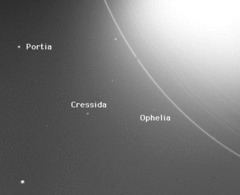Discovery date January 9, 1986 Eccentricity 0.00036 ± 0.00011 Orbital period 11 hours | Mean orbit radius 61,766.730 ± 0.046 km Discovered 9 January 1986 | |
 | ||
Inclination 0.006 ± 0.040° (to Uranus' equator) Similar Stephen P Synnott discoveries, Uranus moons, Other celestial objects | ||
Cressida (/ˈkrɛsᵻdə/ KRES-i-də, Greek: Χρησίδα) is an inner satellite of Uranus. It was discovered from the images taken by Voyager 2 on 9 January 1986, and was given the temporary designation S/1986 U 3. It was named after Cressida, the Trojan daughter of Calchas, a tragic heroine who appears in William Shakespeare's play Troilus and Cressida (as well as in tales by Geoffrey Chaucer and others). It is also designated Uranus IX.
Cressida belongs to the Portia Group of satellites, which includes Bianca, Desdemona, Juliet, Portia, Rosalind, Cupid, Belinda and Perdita. These satellites have similar orbits and photometric properties. Other than its orbit, radius of 41 km and geometric albedo of 0.08, virtually nothing is known about it.
In the Voyager 2 images Cressida appears as an elongated object, its major axis pointing towards Uranus. The ratio of axes of Cressida's prolate spheroid is 0.8 ± 0.3. Its surface is grey in color.
Cressida may collide with Desdemona within the next 100 million years.
